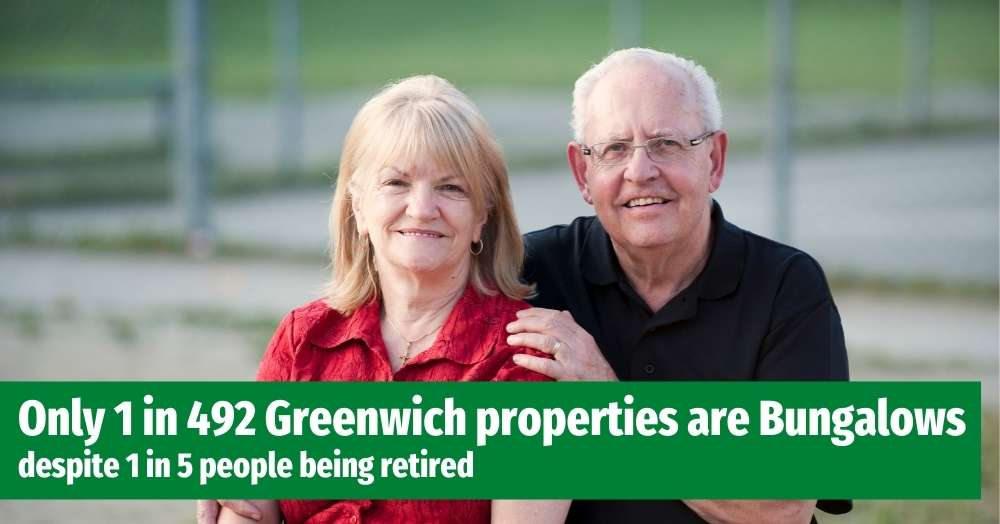With an ageing population, one would think they would be building more bungalows, yet nothing could be further from the truth...
The bungalow is a building that has represented a more leisurely, gentler way of life since the early 1900’s. Bungalows have been sold as an aspiration for those about to retire, saving them the annoyance of having to climb stairs. With an ageing population, one would think they would be building more bungalows, yet nothing could be further from the truth. In fact, this could be one of the main issues that is holding back many mature homeowners moving home, thus creating a bottleneck in the Greenwich property market for the younger families who are being held back and unable to move into the larger homes they so need to grow their families.
So, before I answer that question, let me share this fascinating fact about bungalows. The word ‘bungalow’ originated in India, not the UK. The name is derived from the Hindi word ‘baṅglā’ or the Gujarati word ‘baṅglo’, both of which seem to refer to a home occupied by a Bengali person. The colonial English started to use it for themselves in the late 1600s to describe the same sort of basic lodgings that sailors and staff of the invading East India Company used.
Anyway, back to the here and now in Greenwich.
Unsurprisingly, there are only 22 Bungalows in Greenwich.
When you consider there are 10,819 properties in Greenwich, that means only 0.2% of property in Greenwich are bungalows.
To give you an idea of the age demographic of Greenwich homeowners, there are 798 Greenwich homeowners aged 65 years old (and over) and 1,311 Greenwich homeowners aged between 50 and 64 years of age.
You can see demand for bungalows is only expected to grow. Yet new homes builders are having to deal with soaring land prices meaning to get a profit from the site, they are under pressure to build more vertically than horizontally as with bungalows (as bungalows take up so much more land).
The last available data is from 2018 and only 1.6% new builds in the UK were bungalows, interesting when it was just over 7% in the middle of the 1990s. As British people are living longer, those existing Greenwich bungalow homeowners will be living in them longer, thus creating even more of a bottleneck in the Greenwich property market.
So, what is the answer?
Well with building land in Greenwich at a shortage, maybe new homes builders should be forced under planning rules to reserve ground floor apartments to be set aside for older people to encourage them to move out of larger houses. I would challenge the long-held point of view that building more bungalows in outer areas of London & Home Counties is the pre-eminent way to urge growing numbers of mature ‘last-time buyers’ to move out of their under-occupied Greenwich homes and free up their large homes (where their children have flown the nest) for younger Greenwich families to grow.
With the new Planning Regulations due to be in place in a couple of years, local authorities could require builders to set aside a share of homes for mature residents, as they are already obligated to subsidise local community facilities or low-cost social housing in return for obtaining their planning permission to build in the first place.
Another option would be to convert all those empty shops in our town and city centres up and down the country into residential use. There is no need for planning permission to change offices to residential property and the Government are considering the same for shops (although I have heard of some horror stories of those office to residential developments making rabbit hutches look spacious) – so again, it comes down to the planning laws and making them fit for purpose.
There are no doubt consequences of not designing our housing stock for the 21st Century and beyond for older people.
The population of Greenwich is set to grow by 4,485 to 28,089 by 2040.
As the UK population gets older in the coming decades, as life expectancy is set to grow from 81 years 2 months to 83 years 3 months by 2040, I fully appreciate the need for more Greenwich homes to be built for families, yet one must ask if the planning authorities are focusing too much on new housing for the younger generation, when they in fact should be encouraging new homes builders to develop larger, ground floor two-bedroom homes and decent accessible transport links.
These are my thoughts, what are yours the good people of Greenwich?

